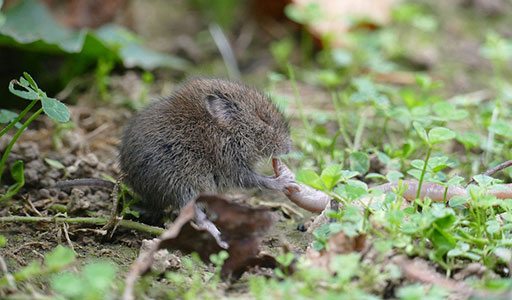Vole Control
Do you need to get rid of voles? We can help!

Vole Removal Strategies
Voles are not necessarily dangerous to humans. However, their droppings and carcasses have been known to carry certain diseases that can be harmful to humans if not handled properly. To avoid potentially harmful diseases or infections, you need to call a Trutech specialist to conduct a vole removal properly. Our licensed specialists have the tools and knowledge that it takes to solve your vole problem quickly. And, our humane vole removal and vole control techniques ensure that no animals are harmed as they are removed from your property.
Don’t wait until your yard has been destroyed by voles to try to solve your problem. When you call Trutech about your vole issue, you can rest assured that your problems are in the best hands. Give us a call today to learn about our environmentally sensitive vole removal methods and a knowledgeable team of specialists.
Hear what a Vole sounds like
Vole Problem

Signs a Vole is on Your Property
Voles are small rodents that are often referred to as “field mice”. Voles are found across the United States, especially in rural areas. These rodents are only about 3-9 inches long when they are fully grown. Voles will dig complicated tunnels underneath your yard or garden, potentially destroying the plants that are growing there. Voles are always looking for plants to eat, so they may be tempted to venture near your property in search of vegetation to eat.

Dangers of Vole Infestation
Since voles eat tree bark, plant seeds, and bulbs, their presence in yards is detrimental to the health of vegetation. Additionally, their burrowing ruins landscaping and can make lawn maintenance difficult or dangerous. Voles sometimes carry diseases such as tularemia and plague, as well.
Humane Vole Removal & Control Strategies

Entry into property
While voles do not usually enter homes, they do frequently gather in yards. Their tendency to burrow underground creates problems for landowners as this behavior overturns soil and uproots plants. Also, the pests can cause structural damage to homes when they dig under buildings.

Trapping & Removal
Large infestations of voles are hard to control. Homeowners who need effective removal should contact trained wildlife control specialists. The experts at Trutech take care of vole problems quickly and humanely.

Prevention & Exclusion
Homeowners can reduce the possibility of finding voles in their yards by removing weeds and other debris that serve as hiding spots. Mowing lawns and maintaining gardens also deters the pests. Finally, erecting fences buried at least six inches into the ground around plants limits their access to food and makes yards less favorable to voles.


